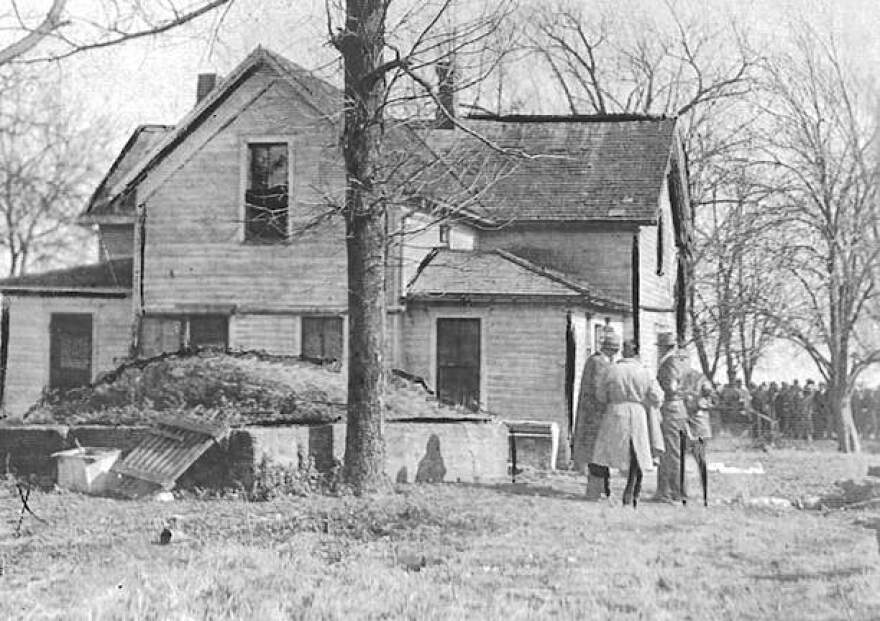http://ozarkspub.vo.llnwd.net/o37/KSMU/audio/mp3/young-brothers-massacre_29513.mp3
In our series about local history, Sense of Place, we bring you in-depth stories about our region’s history and how it’s shaped the Ozarks, Missouri, and the nation. KSMU’s Emma Wilson brings us this story about a deadly January afternoon in the depression-era Ozarks and how its impact reached far beyond.
It was a dry day and 40 degrees in Springfield when 10 law enforcement officers ventured westward a few miles to the Young farm to arrest three criminal brothers. They had a straightforward mission and no way to know they were walking into what would become one of the bloodiest days in American police history. Dr. Brooks Blevins is an associate professor of history and Ozarks studies at Missouri State University. He says that while the Young brothers were out-manned, the officers were out-gunned.
“By the time the smoke clears, six of them have been killed in the shoot-out without ever really seeing the shooters.”
Harry, Paul, and Jennings Young were well known criminals but were considered non-violent, although Harry had been on the run from the law for two and a half years after murdering the City Marshall of Republic. The brothers had been running a massive auto-theft ring in Texas and had returned to their family home in the community of Brookline.
“A sister tried to sell a stolen car to a used car dealer here in Springfield and he was suspicious because the car was not in her name, it was in the name of one of her brothers.”
The next day, she tried again, after getting the title changed to bear her name. But the car dealer told her that she would not be able to sell it to him as it was New Year’s Day and the banks would be closed. The third day, January 2nd, she came to the car dealership with another Young sister to find the police waiting to arrest them. Once the police persuaded one sister to admit the location of her fugitive brothers, they assembled a posse of officers to travel to Brookline to bring them in. The group was a mix of Springfield police and sheriff’s deputies led by Greene County Sherriff Hendrix.
Hendrix had known the Young family as neighbors and community members and thought the brothers would come peacefully. According to Matt Brown, a spokesman for the Springfield Police Department, that was the first mistake.
“There was a level of familiarity there that was his undoing. When he went up to the back door he announced he was there, that he wanted them to come out. And he attempted to kick in the back door and when he did, they were standing there waiting for him and they fatally shot him and his deputy that was standing at the back door with him.”
The ensuing gunfight saw the deaths of four more officers as they tried to use the small trees in the front yard as cover. In all accounts, only Harry and Jennings were in the house, but they were well armed and had plenty of ammunition. The law enforcement officers carried only handguns without backup bullets. Again, Dr. Brooks Blevins.
“In the interim between the ones who were able to escape from the farm house coming back to Springfield to get reinforcements and backup and go back out there, the Young brothers were able to escape.”
The Young Brothers stole yet another car and drove to Houston, Texas, where they holed up in an apartment. They were found by Houston police on January 5th, just three days after the Brookline shootout. After another short gunfight, one of the brothers called out “We’re dead, come on in.” The coroner concluded that they shot each other to avoid capture. The murder of six officers on January 2ndhas become known as the Young Brothers Massacre. Again, Matt Brown.
“It was the single most loss of life for law enforcement in the 20thcentury and it happened here, right in this county. It changed the way law enforcement interacts with criminals from that day forward.”
Brown says that this crime made police departments across the nation reevaluate their methods.
“How did they approach a house? How did they possibly deal with suspects? Were they prepared enough? Did they have ammunition on them in case a shoot-out occurred? Were they behind cover and concealment if something bad did happen? So a lot of their policy was starting to be rewritten from this incident.”
A monument outside the police department lists the names of the officers who died in the massacre. The Young brothers never achieved the fame of other legendary outlaws, likely because of the short time between the massacre and their own deaths, but their crimes remain notorious in police and local history.
For KSMU’s Sense of Place,
I’m Emma Wilson.


